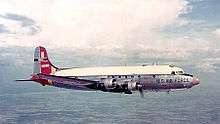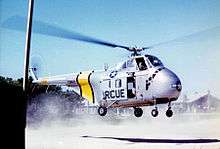57th Rescue Squadron
| 57th Rescue Squadron | |
|---|---|
|
Pararescuemen assigned to Royal Air Force Lakenheath's 57th Rescue Squadron prepare to rappel from an HH-60G Pave Hawk during exercise Joint Warrior 15-1 | |
| Active |
1952–1972 2015–Present |
| Country |
|
| Branch |
|
| Role | Search and Rescue |
| Size | 35 officers and airmen[1] |
| Part of |
United States Air Forces in Europe - Air Forces Africa Third Air Force 48th Fighter Wing 48th Operations Group |
| Garrison/HQ | RAF Lakenheath, United Kingdom |
| Commanders | |
| Current commander | Major Patrick Gruber[1] |
The 57th Rescue Squadron is part of the 48th Fighter Wing at RAF Lakenheath, England. As part of the 48th Operations Group it conducts pararescue operations in support of higher command directives, at times utilizing HH-60G Pave Hawk and Lockheed HC-130 Hercules aircraft. The 57th Rescue Squadron is a combat-ready squadron of pararescue personnel capable of performing combat rescue and personnel retrieval missions in theaters of operations worldwide.
The Squadron will relocate to Aviano Air Base, Italy starting in 2017.[2]
Mission
The 57th Rescue Squadron is a combat-ready search and rescue squadron of composed of USAF Pararescue and Survival, Evasion, Resistance and Escape personnel, capable of executing all-weather search and rescue missions day or night in hostile environments in support of USAFE, USEUCOM, and NATO operations. It employs advanced search and rescue equipment. The squadron is capable of deploying to any theater of operations in the world.
History
.jpg)

The squadron was first activated at Lajes Field in the Azores in November 1952 as the 57th Air Rescue Squadron in a reorganization of Air Rescue Service. The 7th Air Rescue Squadron at Wheelus Field, Libya was expanded into a group and each of its remotely stationed lettered flights was replaced by a new squadron. The 57th replaced Flight B of the 7th Squadron and assumed its personnel and equipment. The squadron mission was to intercept aircraft in distress while crossing the Atlantic and to escort them back to Lajes Field. The 57th also provided search and rescue for both downed aircraft and for ships.[3]
One of the squadron's most notable achievements occurred in 1959, when a Portuguese ship, the SS Arnel, which had struck rocks near the island of Santa Maria. The squadron evacuated 48 persons from the Arnel.[3]

By the early 1960s the squadron had assumed the mission of providing support for Project Gemini and Project Apollo space missions. To reflect this mission, it was renamed the 57th Air Recovery Squadron in July 1965. The following January Air Rescue Service became Aerospace Rescue and Recovery Service and all of its squadrons were renamed, no matter their mission. The squadron was inactivated at Lajes in late 1972, when the Portuguese Air Force assumed the mid-Atlantic rescue mission.[3]
The 57th was reactivated as the 57th Rescue Squadron at Lakenheath in February 2015. Personnel for the squadron came from the 56th Rescue Squadron, with no additional manpower or aircraft. Aircrews and the HH-60G Pave Hawk helicopters remained in the 56th Squadron. The separation of pararescue airmen into a separate unit "align[ed] the personnel recovery function within United States Air Forces Europe to the standard Air Force structure," officials said.[4] Creating two rescue squadrons at Lakenheath is intended to replicate combat conditions because pararescumen frequently deploy separately from their rescue helicopters and planes.[1] The 56th was the last squadron in the Air Force to split its pararescue and flying functions into two squadrons.[5]
Lineage
- Constituted as the 57th Air Rescue Squadron on 17 October 1952
- Activated on 14 November 1952
- Redesignated 57th Air Recovery Squadron on 1 July 1965
- Redesignated 57th Aerospace Rescue and Recovery Squadron on 8 January 1966
- Inactivated on 1 December 1972
- Redesignated 57th Rescue Squadron
- Activated c. 18 February 2015[4]
Assignments
- 7th Air Rescue Group: 14 November 1952
- 9th Air Rescue Group: 8 December 1956
- Air Rescue Service: 24 June 1958
- Atlantic Aerospace Rescue and Recovery Center (later 40th Aerospace Rescue and Recovery Wing):[6] 8 January 1966 – 1 January 1972
- 48th Operations Group: c. 18 February 2015 – Present
Stations
- Lajes Field, Azores, Portugal, 14 November 1952 – 1 December 1972
- RAF Lakenheath, England, c. 18 February 2015 – Present[4]
Aircraft
- Boeing SB-17 Flying Fortress
- Douglas SC-54 (later HC-54D)
- Sikorsky SH-19
- Lockheed HC-130 Hercules
See also
References
Notes
- 1 2 3 Schogol, Jeff (20 February 2015). "New rescue squadron stands up at RAF Lakenheath". Air Force Times. Retrieved 2 May 2015.
- ↑ "UK rescue squadrons to relocate to Italy". Usafe.af.mil. Archived from the original on 17 November 2015. Retrieved 2015-11-13.
- 1 2 3 "History of Airbase 4". United States Consulate Ponta Delgada, Azores. Retrieved 2 May 2015.
- 1 2 3 Mathis, Adam L. (17 February 2015). "Lakenheath rescue squadron to split into 2 units". Stars and Stripes. Retrieved 2 May 2015.
- ↑ Weber, A1C Dawn M. L. (19 February 2015). "57th RQS activation provides stronger, more efficient force". 48th Fighter Wing Public Affairs. Retrieved 2 May 2015.
- ↑ The Atlantic Aerospace Rescue and Recovery Center was a MAC unit at Ramstein Air Base, Germany, performing missions in support of USAFE. Source https://archive.org/stream/airreservist196566unit/airreservist196566unit_djvu.txt
External links
- "57th Rescue (Lajes Fld, Azores)" (PDF). Rotorheads R Us. Retrieved 2 May 2015.
- "Accident description". Aviation Safety Network. Retrieved 2 May 2015. (Details of midair collision between a squadron HC-54D and a HC-97G of the 55th Air Rescue Squadron while filming a training film.)
- "57th Air Rescue Squadron". USAF Patches.com. Retrieved 2 May 2015. (Image of an early 57th Air Rescue Squadron patch)
- Carney, J. C. "One Hell of a Storm". Coast Guard Stories. Retrieved 2 May 2015. (Squadron participation in 1966 rescue of MV Monte Palomares)

